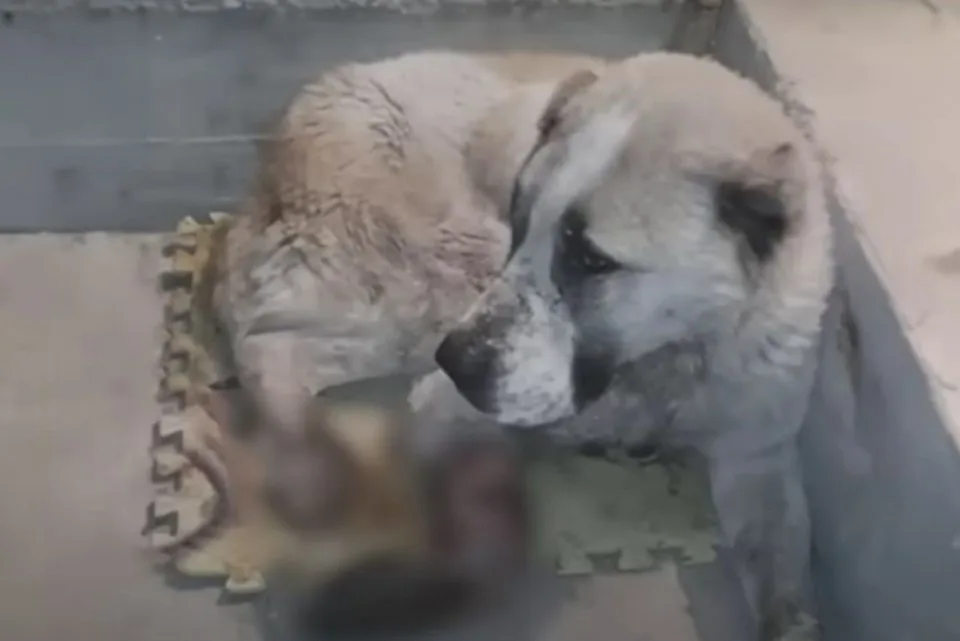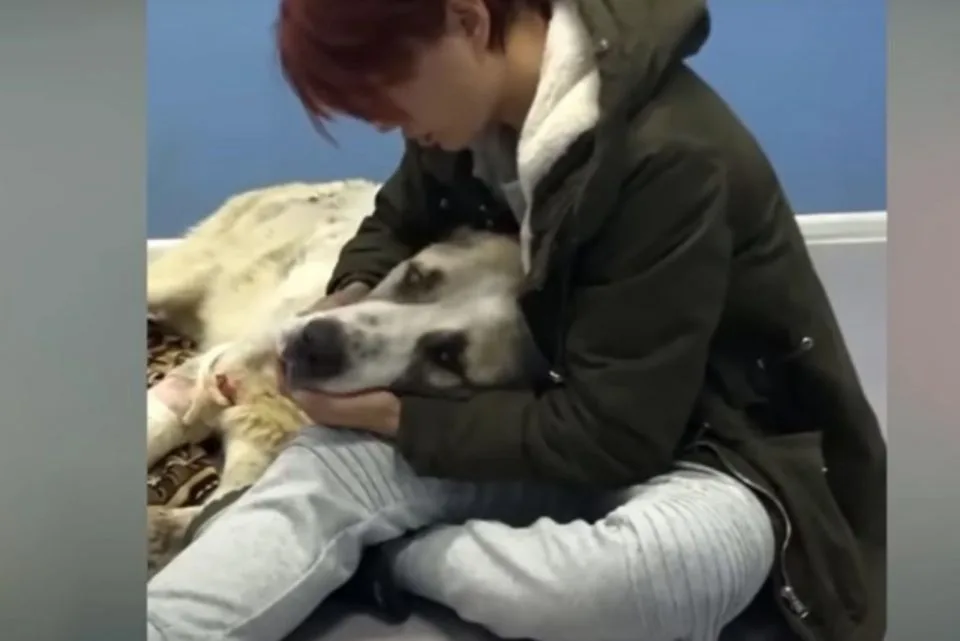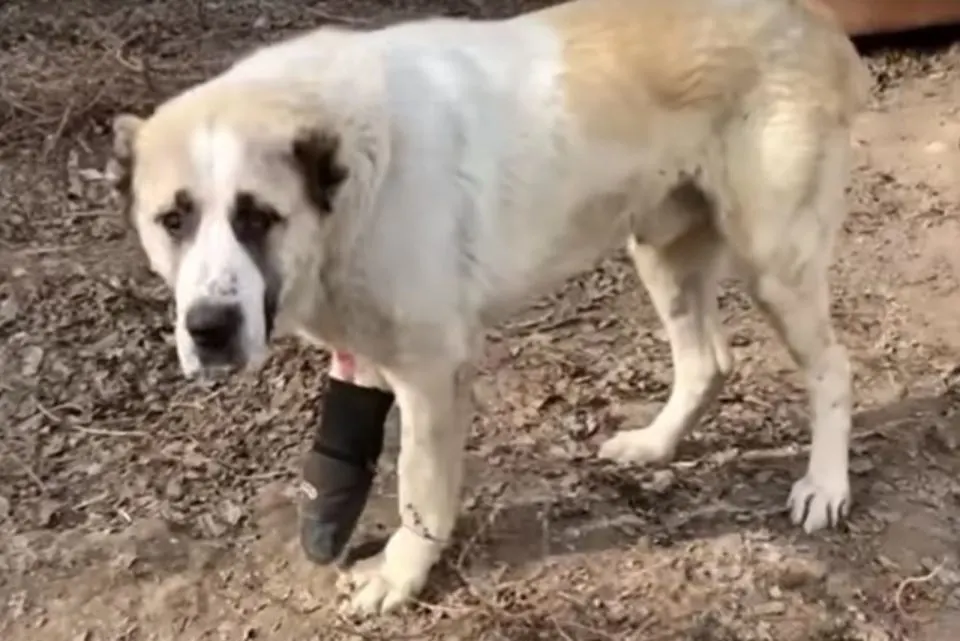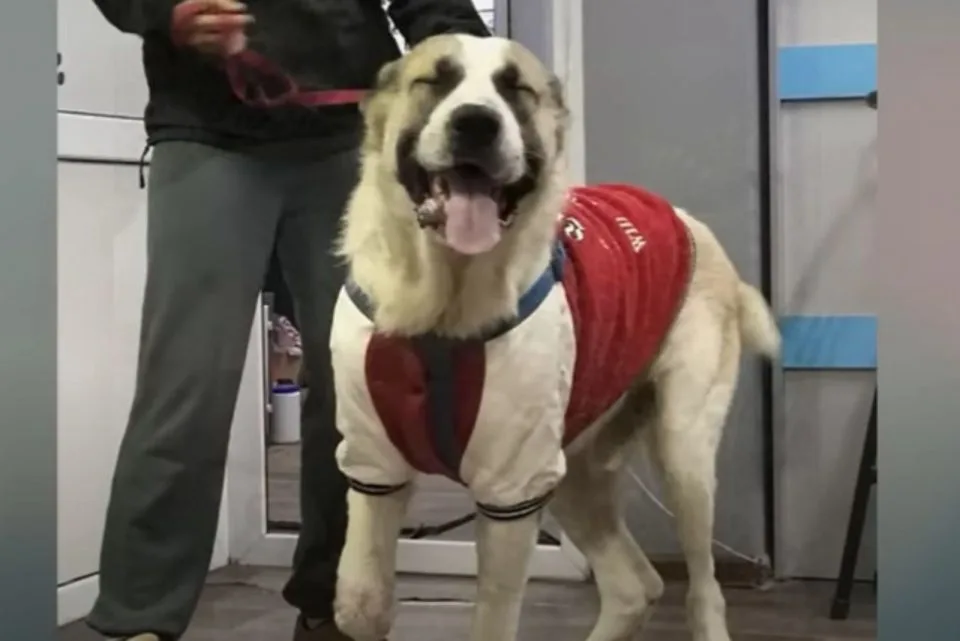When we hear that there is a doggo in need, we take action! From a dire situation on the streets to a new beginning filled with pure joy, this heartwarming story will show you that love and time really do heal.
Once a rescue group heard of a hurt dog lying on the street, they quickly made their way to help. Unfortunately, they weren’t met with a pretty sight.
Rescue Mission

The dog had a necrotic leg, which had been caught in a trap that prevented him from walking and finding himself shelter and food.
When the rescuers quickly assessed the situation, they decided to first give him some food to show him that he can trust them and that they are going to help. After his snack, he was carefully carried to the car and taken to the vet clinic.
Road To Recovery
His injury was quite bad and he needed surgery. Since he lost a lot of blood, a very fluffy and compassionate dog named Tagir came to his aid and donated it.
It would have been a very sad outcome if it wasn’t for his generosity. Thank you, Tagir!

The surgery was successful and the dog was stable again, but sadly, the necrosis was so severe that his leg had to be amputated.
His eyes were very heavy and filled with sadness, and at some point, it was as if he broke down in tears while cuddled up with his rescuer.
He had to be put on antibiotics, which left him tired but they did open his appetite. Even though the nutritious food he ate helped, the shock he was in still took a toll on him.
Luckily, one of the rescuers was by his side throughout his whole recovery.
New Beginning
She named him Zangar, and even adopted him into her loving home. It did take some time for him to adjust to mom’s dogs, his new siblings, but in the end, all of them became best friends.
The road to Zangar’s recovery was long and bumpy, but he got there. At first, his front feet needed to be carried so that he could walk on his back ones, building and activating his muscles. After much effort, he managed to get up and walk all on his own!

Since his days were filled with lots of cuddles, playdates, and love, his recovery was much faster and far less painful.
Now, those sad eyes are long gone and forgotten, replaced by ones that are filled with joy and happiness. He loves spending time with his dog friends, and also with his two-legged ones, knowing what they did for him.

Final Word
It was clear that Zangar was hurt for a long time and nobody tried to help, for if they did, there could have been a much more positive outcome.
So, please, whenever you see an animal who needs aid, contact your local vet or animal rescue and save a life!
If you’ve ever watched your furry friend dozing off, you might have noticed those adorable little twitches and movements that seem to dance across their sleeping bodies. Dogs, much like us, have their own nighttime rituals, and those involuntary twitches are a common sight during their slumber. It’s almost as if they’re chasing rabbits in their dreams or playing fetch in their sleep.
As a seasoned dog enthusiast, you’ve probably pondered the reasons behind these sleep-induced spasms. While it’s easy to assume they’re simply dreaming of their favorite activities, the truth behind why dogs twitch in their sleep is a fascinating topic that delves into the inner workings of our beloved canine companions. So, next time you catch your four-legged buddy twitching away in dreamland, remember there’s more to it than meets the eye.
Understanding Dog Sleep Patterns
The Stages of Dog Sleep
Dogs, like humans, go through different stages of sleep. There are two main types of sleep: REM (Rapid Eye Movement) and non-REM sleep. REM sleep is where most of the dreaming occurs. It’s during this stage that dogs may twitch, move their paws, or bark softly as they dream. Non-REM sleep is a deeper, more restful sleep where the body repairs and regenerates.
How Dogs Differ From Humans in Sleep
While dogs and humans share some similarities in sleep patterns, there are key differences as well. Dogs have shorter sleep cycles than humans, typically lasting about 20 minutes. They can slip into REM sleep quicker than humans, which may explain why they start dreaming sooner after falling asleep. Additionally, dogs may display more physical movements during sleep compared to humans. It’s fascinating to observe these differences and understand the unique sleep patterns of our canine companions.
Unraveling the Mystery: Why Do Dogs Twitch in Their Sleep?
The Scientific Explanation Behind Twitching
When your furry friend twitches in their sleep, it’s often a sign of their brain activity during the Rapid Eye Movement (REM) stage. Research suggests that dogs, like humans, go through different sleep cycles, with REM sleep being the phase where most dreaming occurs. These twitches could be related to the dreams your dog is having, like chasing a squirrel or running in a field.
Common Twitching Behaviors in Dogs
It’s not uncommon to witness your dog twitching, kicking, or softly barking while asleep. These movements are natural and typically harmless. Dogs may twitch more intensively if they are in a deep dreaming state, which is completely normal. However, if the twitching becomes excessive or is accompanied by other concerning symptoms, it’s advisable to consult your veterinarian to rule out any underlying health issues.
Differentiating Between Normal Twitching and Potential Health Concerns
When to Consider Twitching Normal
If your dog is twitching occasionally during sleep, especially when in deep dreaming states, it’s usually a normal behavior. These sporadic twitches are often associated with the REM stage, indicating an active dream phase. You might notice your dog making small movements like kicking their legs or softly barking. These behaviors are generally harmless and a sign that your furry friend is experiencing a vivid dream.
Signs of Possible Health Issues
While occasional twitching is normal, excessive or violent twitching could be a cause for concern. If you observe your dog having frequent, intense twitching episodes or displaying other unusual symptoms like vocalizing in distress or abnormal bodily movements during sleep, it’s essential to consult your veterinarian. These signs could potentially indicate underlying health issues that require professional evaluation to ensure your dog’s well-being.
The Role of Dreams in Dog Twitching
Can Dogs Dream Like Humans?
Dogs experience similar sleep cycles to humans, including the REM stage where dreaming occurs. Research suggests that dogs exhibit brain activity during sleep that resembles human dreaming patterns. While it’s not confirmed whether dogs have complex dreams like humans, their twitching during sleep indicates some level of dream activity. This similarity in sleep patterns raises the possibility that dogs may indeed dream, albeit in a different way than we do.
Deciphering What Dogs May Dream About
Deciphering the content of a dog’s dream is an intriguing yet challenging task. Oftentimes, a dog’s twitches during sleep may mirror its daily activities or experiences. For example, if your dog loves chasing squirrels in the park, you might observe twitching movements that mimic this behavior during sleep. Dogs may also dream about routine activities, such as playing fetch or interacting with their favorite humans. While we can’t definitively determine what dogs dream about, their twitches could offer glimpses into their subconscious thoughts and desires.
How to Ensure a Good Night’s Sleep for Your Dog
Creating a Comfortable Sleeping Environment
To help your furry friend get a good night’s sleep, make sure to provide a cozy and peaceful sleeping area. Choose a comfortable bed that suits your dog’s size and sleeping habits. Consider factors like cushioning, warmth, and adequate space to stretch out. You might want to place the bed in a quiet spot away from loud noises or bright lights to promote better rest.
Addressing Sleep Twitching: Tips for Dog Owners
If you notice your dog twitching frequently during sleep, there are a few things you can do to help. Ensure your dog gets enough exercise during the day to reduce excess energy that may lead to twitching. Avoid giving stimulating treats or activities close to bedtime. Providing a calming bedtime routine can also help your dog relax before sleep. Remember, if twitching seems excessive or is accompanied by other concerning symptoms, consulting your veterinarian is always a good idea to rule out any underlying health issues.
Conclusion
So, there you have it – dogs twitching in their sleep might just be them living out their own little adventures in dreamland. While we may not fully understand the depths of their dreams, it’s fascinating to think about what they could be experiencing. Remember, if you notice your furry friend twitching excessively, it’s always best to consult with your vet to rule out any underlying issues. By making sure your pup has a cozy sleep environment and incorporating regular exercise and bedtime routines, you can help them have sweet dreams and peaceful nights. Sweet dreams to your four-legged companion!
Frequently Asked Questions
1. Why do dogs twitch in their sleep?
Dogs twitch during sleep due to brain activity in the REM stage, indicating potential dreaming behavior.
2. Are a dog’s twitches related to its dreams?
Yes, a dog’s twitches might mirror its dream content; for example, it could be dreaming about chasing squirrels.
3. How do dogs’ dream complexities compare to humans?
The complexity of dogs’ dreams compared to humans is uncertain, but research shows similarities in their sleep patterns.
4. When should I consult a vet about my dog’s twitching?
Consult a vet if your dog exhibits excessive twitching during sleep for proper evaluation and advice.
5. How can I help my dog with twitching while sleeping?
Create a comfortable sleeping environment for your dog, incorporate exercise into its routine, establish bedtime habits, and seek veterinary guidance when needed.
[no_toc]

Hey there, I’m Janet Brooks, a dog-loving student from California. I’m all about helping pups in need, especially those without homes. Me and my awesome friends work together to give shelter and love to stray dogs. Oh, and I also write blogs about dogs to share helpful info.